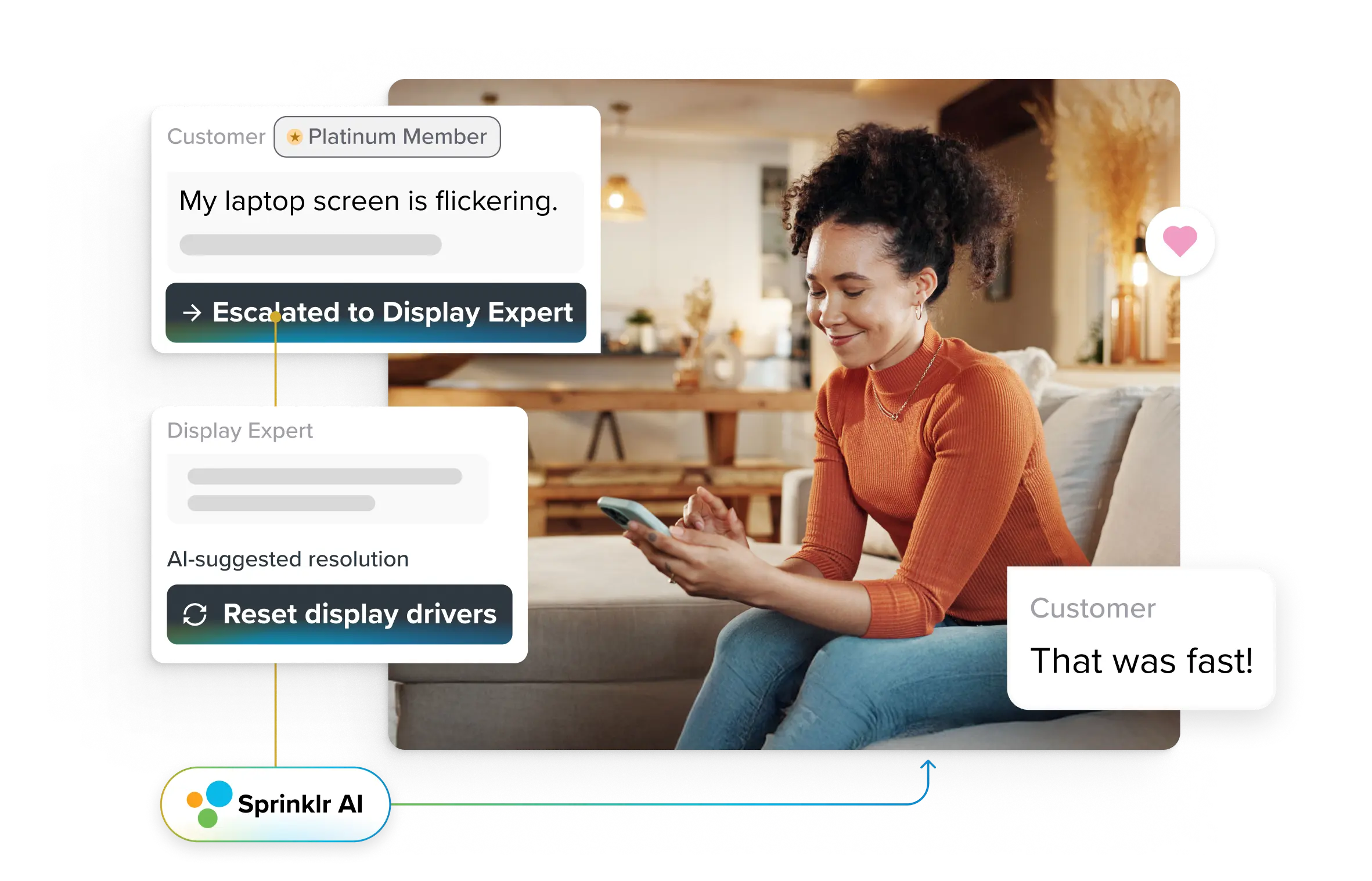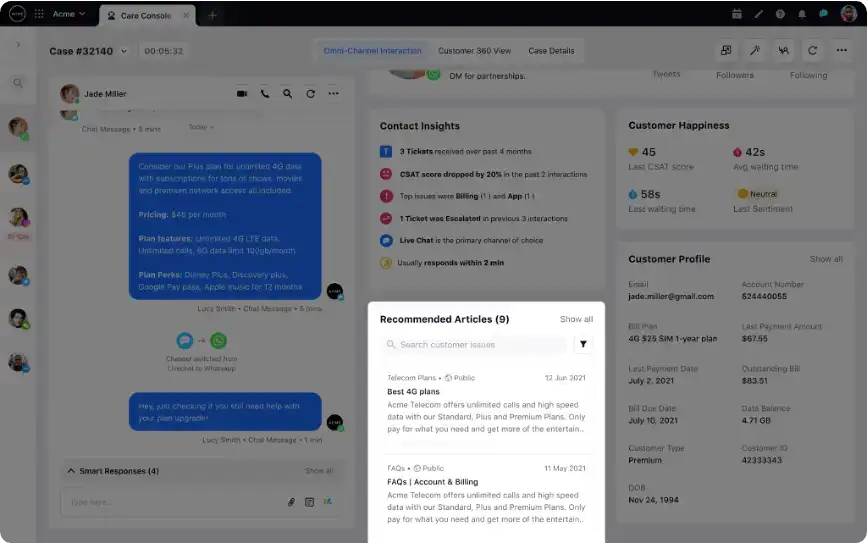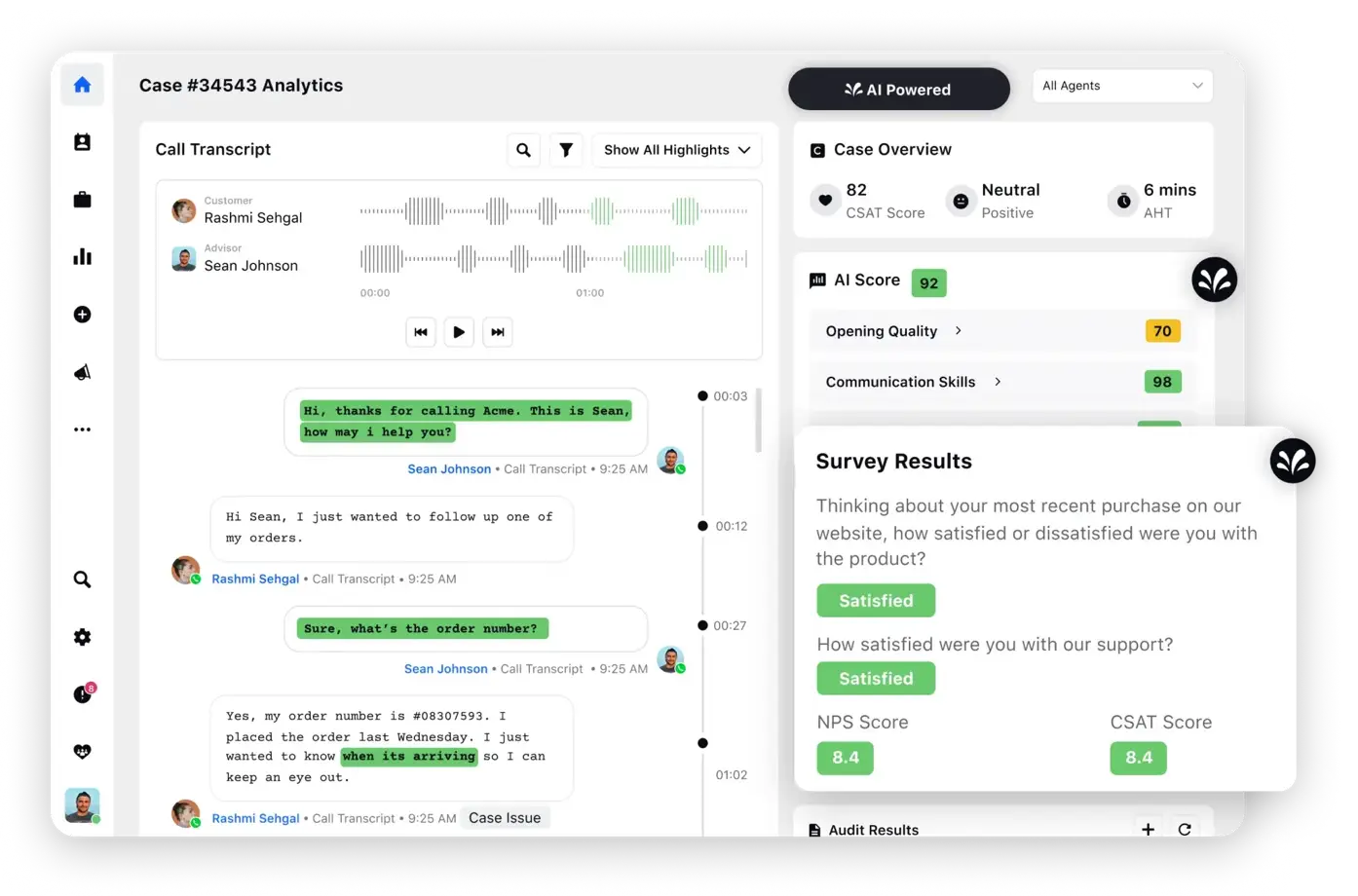Transform CX with AI at the core of every interaction
Unify fragmented interactions across 30+ voice, social and digital channels with an AI-native customer experience platform. Deliver consistent, extraordinary brand experiences at scale.

First Contact Resolution: How to Improve Customer Service
First contact resolution (FCR) is one of the most important metrics in enterprise customer service. It reflects how well-versed your support team is in solving issues without having customers bounce between agents or channels. According to some surveys, top-performing contact centers are hitting FCR rates of 74 percent or higher. The closer you get to that benchmark, the more efficient your operations become and the more loyalty you earn. But how do you get there? In this post, you’ll learn why FCR matters more than ever, what could be dragging your numbers down and what it takes to improve them.
What is first contact resolution?
First contact resolution measures the percentage of customer issues resolved during the very first interaction — without any follow-up, transfer or need for the customer to recontact support. It's a holistic indicator of how effectively your support team can diagnose, address and close a case in one go, across any channel — whether that's phone, email, chat, social media or messaging.
Importantly, FCR applies to all customer service touchpoints — unlike First Call Resolution, which is specific to voice-based channels. A high FCR rate means your support operations are not only efficient but also customer-centric: your agents are resolving issues quickly and thoroughly, your customers aren’t stuck repeating themselves and your business isn’t losing money on redundant interactions.
It’s also a diagnostic metric. A low FCR rate often signals knowledge gaps, unclear processes or system limitations that get in the way of effective support.
FCR vs First Response Time (FRT): What’s the difference?
While FCR is about getting it right, First Response Time (FRT) is about getting there fast.
- FRT tracks how quickly your team acknowledges or replies to a customer inquiry.
- FCR tracks whether that reply actually solved the customer’s problem and did so in one go.
Think of it this way: a fast response that doesn’t resolve the issue may improve FRT, but it won’t move your FCR. Speed gets attention. Resolution earns trust.
How to calculate first contact resolution (formula and benchmarks).
Calculating the first contact resolution rate is straightforward. You can use this formula:
For example, if your team resolved 740 issues on the first try out of 1,000 total contacts, your FCR rate is 74%.
What counts as resolved? A resolution means the customer’s issue is fully addressed to their satisfaction during that first interaction, with no need for follow-up calls, emails or escalations.
For support teams, an FCR rate between 70 and 80 percent is generally considered a strong benchmark. Hitting this range means you’re balancing efficiency with quality service.
One challenge to watch for: measuring FCR gets more complex when customers reach out through multiple channels, like phone, live chat, email or social media. Keeping track across all those touchpoints requires you to use an omnichannel customer service solution that helps you marry all your touchpoints in a unified workspace.
5 strategies to improve first contact resolution in 2025
Your enterprise must adopt a comprehensive approach to resolve complaints that integrates people, processes and technology to drive meaningful improvements in FCR. Here’s how you can do that:
1. Benchmark your FCR, then trace what’s holding it back
Start by placing your FCR rate in context — not just against static industry averages, but against your own business model, query types, and support complexity. A benchmark might be standard, but what’s normal for a routine IT helpdesk isn’t realistic for a healthcare support center handling high-stakes queries.
Once you’ve set a meaningful baseline, dig into what’s dragging your numbers: Are cases being escalated unnecessarily? Are agents lacking system access or product knowledge? Are customers repeating themselves across channels? Use customer feedback, call audits and agent debriefs to surface these bottlenecks.
2. Use AI-driven routing and sentiment detection to match context with expertise
FCR improves when customers are paired with agents who not only have the right skillset but also understand the emotional temperature of the conversation. AI-powered routing uses case context, historical data and intent signals to assign queries to the best-fit agent — not just the next available one.
Combine that with real-time sentiment analysis and your agents can adapt their approach instantly, prioritize urgent cases and defuse angry customer issues and tense situations early — increasing the odds of resolving the issue in the first contact itself.
3. Equip agents with continuous training and knowledge base access
Your agents are the face of your brand. Ongoing training keeps them sharp and knowledgeable about your products, processes and customer expectations. Coupled with a dynamic, easily accessible knowledge base, they gain the confidence and resources to solve issues quickly and accurately, cutting down repeat contacts and boosting customer trust.
To speed up the FCR, you may even equip your agents with an AI tool like Sprinklr AI that can automatically scout and scan through your knowledge base to surface relevant solutions and answers that troubleshoot your customer’s problem in real-time.

Bonus Watch: Must-have features for the best knowledge base software | CX Unplugged
4. Give agents full context with unified customer history across channels
FCR often breaks down not because the solution is complex but because the context is missing. When support teams work without a connected view of past interactions, they waste valuable minutes revalidating customer details, duplicating steps or chasing information that already exists elsewhere.
A unified customer history solves this by aggregating every touchpoint — from chat logs and call transcripts to purchase records, prior escalations and even unresolved tickets — into a single, real-time timeline. This continuity allows agents to enter conversations with precision. It minimizes repetition, prevents conflicting advice and makes the customer feel remembered, not restarted. In effect, it shifts support from reactive firefighting to intelligent resolution at first contact.
5. Capture post-interaction feedback to refine root causes
FCR metrics lose meaning if you don’t understand why a case was or wasn’t resolved on first contact. Post-interaction feedback loops bridge that gap by capturing the customer’s experience in real time — not just whether the issue was technically closed, but whether it felt resolved.
- Was the agent’s response clear?
- Did the customer have to re-explain their problem?
- Were they transferred unnecessarily?
When tied back to agent actions, resolution paths and system triggers, this feedback becomes diagnostic. It shows where knowledge articles fall short, where workflows create drag or where agent decisions could be sharpened. Over time, these micro-insights drive macro shifts, targeted coaching, smarter automation and process redesigns that reduce failure points before they recur.
That’s where Sprinklr Surveys come in.
It embeds survey capture directly into your service flows across 30+ channels — from IVR and live chat to social DMs — enabling real-time VoC collection at the point of resolution.
Under the hood, Sprinklr’s AI performs granular, phrase-level sentiment analysis to extract intent, friction signals and resolution clarity.
It maps these insights back to case metadata, agent ID, handling time, channel path, helping you diagnose root causes.
Real-time escalation prediction uses tonal shifts, message intensity and behavioral patterns to flag at-risk conversations before they spiral. And with drillable dashboards and attribution-ready reporting, you get a clear line of sight into what’s holding your FCR back.

Challenges in achieving high first contact resolution
FCR is rarely held back by one obvious flaw. It’s usually the outcome of layered issues: broken data flows, poor handoffs, tooling sprawl and gaps in frontline decision-making. Below are five enterprise-grade challenges that routinely undercut FCR and what it takes to solve them.
1. Siloed systems that block contextual resolution
- Challenge: When customer data is trapped in CRM and help desk systems that don’t talk to each other, agents end up blind to the full customer journey. That leads to repetitive questioning, missed context and incomplete resolutions.
- Solution: Centralize customer interaction data across digital, voice and back-office systems. With Sprinklr Service, teams get a real-time, unified customer profile, enabling agents to resolve with full journey context.
2. Legacy routing logic that ignores context
Challenge: Many routing systems still rely on static rules — channel type, customer tier, or manual tagging. These ignore intent, sentiment and agent skill alignment, leading to misroutes, transfers and longer handling time.
Solution: Use AI-powered, intent-based routing to match customers with the best-fit agent based on skill, availability, interaction history and urgency. Sprinklr’s omnichannel engine reroutes dynamically if sentiment drops mid-interaction, keeping FCR intact.
3. Global support, local inconsistencies
Challenge: Enterprises serving multiple markets often struggle to deliver consistent resolution quality across languages, regions and time zones. Translation gaps and mismatched processes lead to higher repeat contacts.
Solution: Equip agents with live translation, localized workflows and consistent playbooks. Use a customer service solution that supports multilingual customer service with real-time translation and intent-aware routing, so customers get the same quality of resolution, whether they’re in Tokyo or Toronto.
Real-world success: How Tawuniya Insurance scaled first-time resolutions
As one of the leading insurance providers in the Middle East, Tawuniya serves millions of customers across multiple touchpoints. However, siloed systems and fragmented support workflows were holding back their ability to respond quickly and consistently.
To solve this, Tawuniya adopted Sprinklr Service to unify its contact center operations.
With AI-powered case routing, real-time agent assistance and a single view of customer history, the impact was immediate:
- 21% boost in FCR
- 95% faster case resolution
- 25% increase in CSAT
The result? A leaner, smarter service operation that scales support without compromising customer experience.
What your FCR rate actually tells you and what to do about it
FCR is a feedback signal on how your systems, agents and workflows perform under real conditions. But to make that signal useful, you need to know how to read it and what to tie it to.
1. Start with the right definition
Only count a case as resolved on first contact if:
- The issue was fully addressed without escalation, transfer or follow-up
- The customer didn’t re-open a case or create a related one within X hours (define a recontact window that suits your business — typically 24–72 hrs)
Avoid inflating FCR with partial resolutions or tickets marked closed too early.
2. Segment your FCR
Don’t just track FCR at the org level. Break it down by:
- Channel (chat, email, voice, social)
- Issue type (billing vs technical vs account)
- Region or team
- Customer type (new vs returning, high-value vs low-touch)
This tells you where the breakdown is and what resolution really means in context.
3. Pair FCR with experience signals
On its own, FCR tells you whether the issue has been solved. It doesn’t tell you:
- If the customer felt it was a fair resolution
- If the solution was understood
- If the customer left feeling heard
Pair it with CSAT, NPS or even customer effort score (CES). For example:
- High FCR + Low CSAT → Fast but tone-deaf resolution
- Low FCR + High CES → Customers feel like they’re working too hard
- Low FCR + High NPS → Brand is strong, but operations aren’t keeping up
4. Use FCR dips to diagnose process gaps
When FCR drops, don’t just train harder — investigate smarter:
- Are escalations spiking? → Check routing rules
- Are resolution times bloating? → Look at tool lag or access issues
- Are agents flagging missing knowledge? → Update documentation, not just coaching
Use metadata from low-FCR tickets to trace exactly where momentum is lost.
What happens when everything finally works together?
Ask Tawuniya Insurance. They were juggling millions of customers across disconnected channels — with fragmented systems slowing everything down. Resolution times lagged. FCR took a hit. Customers felt it.
Then they switched to Sprinklr Service.
With unified customer history, AI-powered routing and real-time agent assistance, they didn’t just fix the problem but yielded amazing results.
- 21% jump in FCR
- 95% faster case resolution
- 25% lift in CSAT
That’s simply faster, smarter, cleaner support that Sprinklr helped them build. And if you’re facing the same chaos in your contact center, it’s probably time.
Let’s fix it at the first contact.
Frequently Asked Questions
A good FCR rate usually ranges between 70% and 80%, depending on the industry. High-performing companies aim for 80% or above to ensure smooth and efficient customer service. The closer you get to these numbers, the better your support team is at solving issues quickly.
FCR is crucial because it directly influences customer satisfaction and loyalty. Resolving issues on the first contact reduces repeat calls, which lowers operational costs and eases the workload on agents. It also helps build a reputation for reliable and effective customer support.
Several factors impact FCR, including how well-trained agents are and their access to up-to-date customer information. Technology challenges, such as siloed systems or slow response tools, also play a big role. Plus, complex customer problems and inconsistent processes can lower FCR rates.
AI improves FCR by intelligently routing inquiries to the most qualified agents, reducing transfers and delays. It also provides agents with live suggestions and sentiment analysis, helping them resolve issues faster. Automating routine tasks lets agents focus on more complex problems, improving first-time solutions.
Enterprises can use platforms like Sprinklr Service, which provide a unified view of all customer interactions across channels. These tools offer real-time dashboards, AI-driven insights and workflow automation to monitor and boost FCR. Having the right technology helps teams spot issues early and optimize support processes efficiently.









